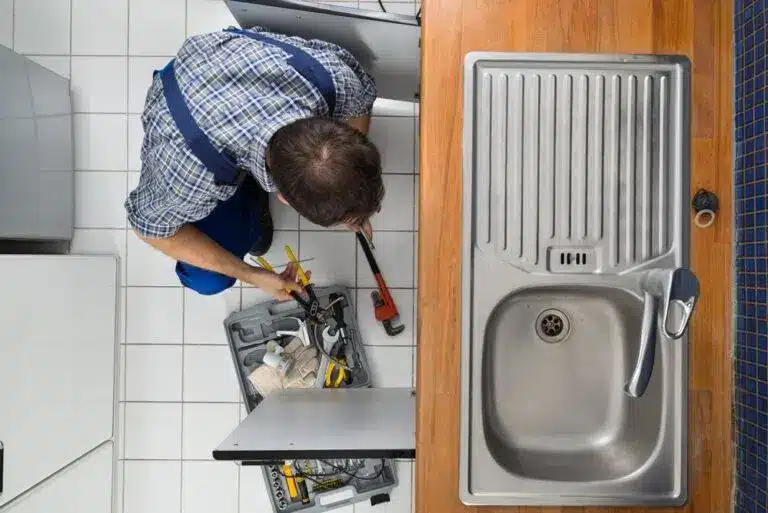Recommended Tips for Fixing a Leaking Waste Disposal Unit
Recommended Tips for Fixing a Leaking Waste Disposal Unit
Blog Article
Are you interested in info about Why Is My Garbage Disposal Leaking From the Bottom??

Waste disposal unit are crucial kitchen appliances that help in throwing away food waste successfully. Nonetheless, a leaking garbage disposal can be a discouraging and messy issue to deal with. Thankfully, several leakages can be taken care of conveniently with a couple of simple steps. In this write-up, we will talk about exactly how to deal with a dripping waste disposal unit effectively.
Introduction
Garbage disposals are installed under cooking area sinks and are created to shred food waste into smaller sized items, allowing it to travel through the plumbing system conveniently. While these tools are usually reputable, leaks can occur over time as a result of damage, loosened links, or damages to the system.
Step-by-Step Overview to Repairing a Dripping Waste Disposal Unit
Turn Off the Power
Before attempting any repair work, guarantee that the power to the waste disposal unit unit is shut off to prevent the threat of electrical shock.
Locate the Leak
Identify the specific area of the leak and figure out the cause
Tighten up Links
Make use of a wrench to tighten any kind of loose links between the disposal system and the pipes system.
Replace Seals or Gaskets
If the leakage is because of used seals or gaskets, get rid of the old parts and change them with new ones.
Patching Cracks or Holes
For fractures or holes in the disposal system, use epoxy or a suitable patching product to secure the damaged area.
Recognizing the Resource of the Leak
Prior to attempting to fix a dripping garbage disposal, it is essential to recognize the source of the leakage. This can usually be done with visual inspection or by carrying out simple examinations.
Visual Inspection
Check the garbage disposal device carefully for any signs of water leakage. Pay attention to areas around seals, gaskets, and connection points.
Evaluating for Leakages
One way to test for leakages is by running water via the disposal system and checking for any visible indicators of leak.
Common Root Causes Of Leaks in Rubbish Disposals
Worn Seals and Gaskets
Seals and gaskets play a critical duty in stopping water from dripping out of the waste disposal unit. In time, these elements can wear away, leading to leaks around the disposal system.
Loose Connections
The links in between the garbage disposal and the pipes system can end up being loosened over time, creating water to leak out during procedure.
Cracks or Openings in the Disposal System
Physical damages to the garbage disposal, such as fractures or holes in the real estate, can likewise cause leaks.
Devices and Materials Needed for Dealing With a Dripping Waste Disposal Unit
Prior to beginning the repair procedure, collect the required tools and products, including a screwdriver, adjustable wrench, plumber's putty, replacement seals or gaskets, and epoxy or patching product for repairing fractures or holes.
Examining the Waste Disposal Unit After Fixing
When the repair is complete, evaluate the waste disposal unit by running water with it to guarantee that the leakage has been fixed.
Preventive Upkeep Tips to Avoid Future Leaks
To prevent future leakages, it is necessary to execute normal upkeep on your garbage disposal. This consists of maintaining it clean, staying clear of placing non-food items or tough objects down the disposal, and periodically looking for leaks or various other concerns.
Conclusion
In conclusion, fixing a leaking waste disposal unit is a relatively straightforward process that can be completed with basic tools and products. By complying with the actions described in this short article and practicing preventive maintenance, you can maintain your garbage disposal in good working condition and prevent pricey repair work in the future.
HERE’S HOW TO FIX YOUR GARBAGE DISPOSAL
WHAT TO DO IF SOMETHING IS STUCK IN YOUR GARBAGE DISPOSAL
If the impeller won’t turn, there’s probably something stuck in the disposal. It could be a steak bone or peach pit, although plumbers report pulling all sorts of inappropriate objects out of disposals, such as bottle caps or aluminum foil. Make sure power to the disposal is off, and look inside to see if you can see the source of the jam.
Never stick your fingers in a disposal. Pull out anything you see with tongs or pliers.
If the disposal still won’t work, it may be time to call a plumber or consider buying a new disposal. GEM Plumbing & Heating is here for all of your garbage disposal needs.
WHAT TO DO IF YOUR GARBAGE DISPOSAL DRAIN IS CLOGGED
Take everything out from underneath your sink and put a bucket or other container under your disposal to catch any water that drains out. Disconnect your disposal from the power supply. If it’s plugged into a wall outlet, unplug it. If it’s hardwired into an electrical box, go to the electrical panel and turn off the breaker for the disposal. Pour ¼ cup of baking soda into the drain, followed by ½ cup of white vinegar. Give the solution a few minutes to fizz and do its work. Look into the disposal with a flashlight to see if you can see an object that might be causing the clog. If you see it, remove it using tongs or pliers. MORE TIPS ON DEALING WITH A CLOGGED GARBAGE DISPOSAL
Never use drain cleaner in a garbage disposal. It can damage the plastic parts inside the disposal. You can also be splashed with the caustic liquid while working to clear the clog. Beware! Never stick your fingers into a garbage disposal. Trust us — not a good idea. In many instances, your dishwasher drains through your garbage disposal. This allows the disposal to grind any large food particles that may be drained out of your dishwasher. There are some jurisdictions, however, where the plumbing code prohibits such a connection. WHAT TO DO WHEN YOUR DISHWASHER DRAINS THROUGH THE DISPOSAL
Run some water in the sink so your plunger has at least a ½-inch of water to create a seal and plunge vigorously up and down several times. You may need to repeat this several times. Run hot water down the drain to clear any residue that remains.

We were shown that write-up on Why Is from an associate on our other web property. Liked our write-up? Please share it. Let others discover it. Thank you for your time. Come back soon.
Contact Us Report this page